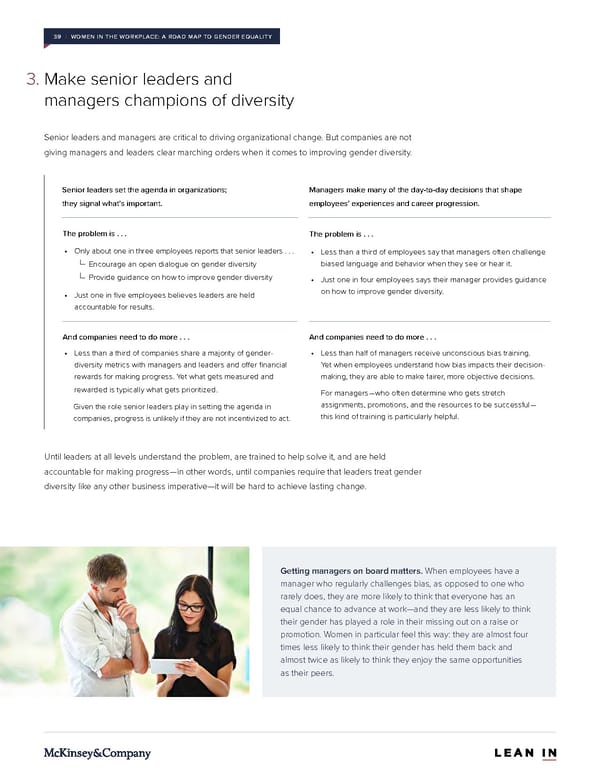39 | WOMEN IN THE WORKPLACE: A ROAD MAP TO GENDER EQUALITY 3. Make senior leaders and managers champions of diversity Senior leaders and managers are critical to driving organizational change. But companies are not giving managers and leaders clear marching orders when it comes to improving gender diversity. Senior leaders set the agenda in organizations; Managers make many of the day-to-day decisions that shape they signal what’s important. employees’ experiences and career progression. The problem is . . . The problem is . . . • Only about one in three employees reports that senior leaders . . . • Less than a third of employees say that managers often challenge Encourage an open dialogue on gender diversity biased language and behavior when they see or hear it. Provide guidance on how to improve gender diversity • Just one in four employees says their manager provides guidance • Just one in five employees believes leaders are held on how to improve gender diversity. accountable for results. And companies need to do more . . . And companies need to do more . . . • Less than a third of companies share a majority of gender- • Less than half of managers receive unconscious bias training. diversity metrics with managers and leaders and offer financial Yet when employees understand how bias impacts their decision- rewards for making progress. Yet what gets measured and making, they are able to make fairer, more objective decisions. rewarded is typically what gets prioritized. For managers—who often determine who gets stretch Given the role senior leaders play in setting the agenda in assignments, promotions, and the resources to be successful— companies, progress is unlikely if they are not incentivized to act. this kind of training is particularly helpful. Until leaders at all levels understand the problem, are trained to help solve it, and are held accountable for making progress—in other words, until companies require that leaders treat gender diversity like any other business imperative—it will be hard to achieve lasting change. Getting managers on board matters. When employees have a manager who regularly challenges bias, as opposed to one who rarely does, they are more likely to think that everyone has an equal chance to advance at work—and they are less likely to think their gender has played a role in their missing out on a raise or promotion. Women in particular feel this way: they are almost four times less likely to think their gender has held them back and almost twice as likely to think they enjoy the same opportunities as their peers.
 Women in the Workplace Page 45 Page 47
Women in the Workplace Page 45 Page 47